Fig. 6.1
Scanning electron micrograph depicting the apical third of a human molar. Original magnification = ×5,000
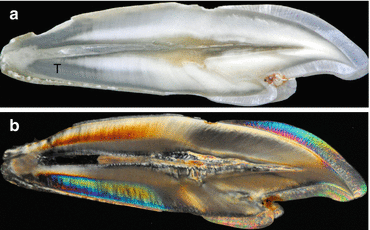
Fig. 6.2
(a) Longitudinal section of a mandibular canine with transparent dentin (T) forming on the apical third. In (b) the same section is shown in polarized mode
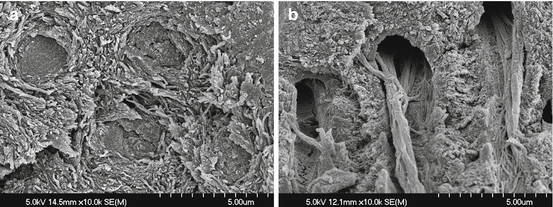
Fig. 6.3
Scanning electron micrograph depicting fractured dentin specimens. (a) Transparent dentin with tubules obliterated with mineral deposits; (b) normal root dentin showing patent tubules. Original magnification = x10,000
Table 6.1
Changes in dentin substrate with aging
|
The mineral concentration is higher in transparent dentin than in normal dentin
|
|
Obliteration of the dentinal tubules by increased deposition of peritubular matrix
|
|
Transparent dentin, unlike normal dentin, exhibits almost no yielding before fracture
|
|
Flexural strength and strain to fracture of dentin decreased significantly with age
|
|
Fracture toughness is lowered by roughly 20 % in transparent dentin
|
|
Aging results in an increase in the rate of damage initiation and propagation in dentin
|
|
Decrease in dentin permeability with aging
|
|
Older dentin contains less water than younger dentin
|
|
Hardness and modulus of elasticity of aged dentin are higher than those of young dentin
|
|
The density of odontoblasts and pulp fibroblasts decreases in older dentin
|
|
Transparent dentin accumulates in the apical third of the root resulting in and variations in tubule diameter and mineral deposits in the tubules
|
|
Fatigue strength of young dentin is greater than that of older dentin
|
|
Sclerotic and old dentin results in thinner hybrid layers, with short resin tags, and fewer lateral branches than normal dentin
|
6.2 General Principles for All Prefabricated Passive Posts
The ability of dentists to restore endodontically treated teeth increases the chance of patients retaining teeth that were formerly condemned to extraction. All teeth require a definitive restorative treatment after the root canal therapy is completed and deemed successful. Failure to adequately restore the endodontically treated tooth may cause endodontic failure (Safavi et al. 1987).
Intra-radicular metal posts double the fracture resistance of endodontically treated teeth (Kantor and Pines 1977). A dowel was considered necessary to prevent root fracture of endodontically treated teeth long before the introduction of fiber-reinforced resin posts (or fiber posts) and zirconia posts (Randow and Glantz 1986; Goodacre and Spolnik 1994).
A few classical principles are still used currently for all types of dowels. Some of these concepts may not extrapolate directly to fiber posts due to the differences in composition, physical properties, and distinct luting techniques. Posts are retained in the root canal either actively or passively. Active posts engage the dentinal walls of the preparation upon insertion, whereas passive posts do not engage root dentin walls, relying instead on a luting material for retention (Smith et al. 1998). Passive posts are, therefore, less retentive than active posts. Active posts create more stresses during placement, which may favor the vulnerability of the root structure to fracture. In order to avoid root fracture, the use of passive tapered posts has been recommended (Gutmann 1992; Morgano 1996). When a passive post is used, its retention relies highly on the adaptation of the post to the root canal wall and the luting agent layer (Schmage et al. 2005). A cement joint value between 24 and 31 μm for the cast post, and 30 and 50 μm for the prefabricated post, may be required to minimize the failure rate of posts (Johnson and Sakumura 1978).
The longevity of restored endodontically treated teeth is affected by many factors including the post design, length, and thickness, the ferrule effect, cementation, and the amount of residual tooth substance (Lassila et al. 2004; Ferrari et al. 2012; Juloski et al. 2012). In the past clinicians and researchers have assumed that a post should be rigid (Torbjörner et al. 1996). A rigid post is capable of resisting loads without distortion. However, stresses are transferred to the less rigid component, in this case root dentin, which may result in mechanical failure (Torbjörner et al. 1996). Other factors may influence the load capability of endodontically treated teeth. The tooth morphology, the restorative techniques, and, more importantly, the amount of remaining tooth structure are fundamental variables that influence the mechanical resistance of endodontically treated teeth (Trope et al. 1985; Gutmann 1992; Sornkul and Stannard 1992; Fernandes and Dessai 2001).
A higher modulus of elasticity (greater rigidity) of the post material, besides a wider post diameter (or thickness), has been associated with increased stress values at the post-dentin interface. It has been suggested that a post should have the same modulus of elasticity (rigidity) as root dentin to distribute applied forces evenly along the length of the post (Assif et al. 1989), thus avoiding stress concentration and minimizing the risk of root fractures. This requirement seems to be fulfilled by current fiber posts, as their elastic modulus is similar to that of dentin (Zicari et al. 2013a). The elastic modulus of fiber posts is more similar to that of dentin than the elastic modulus of other types of posts (Asmussen et al. 1999).
Fiber posts distribute stresses more uniformly along the cement–dentin interface and to the remaining tooth structure. In contrast, the moduli of elasticity of alloys used for cast posts are much higher.
6.3 Post Design
6.3.1 Post Length
As discussed in Chap. 1, Abramovitz et al. (2001) demonstrated that 3 mm of gutta-percha provided an unpredictable in vitro apical seal; therefore, at least 5 mm would be recommended (Fig. 6.4). When posts were two thirds of the root length, many of the average and short root length teeth had compromised apical seals. When the post was equal to the crown length, an adequate seal was only possible on teeth with average or long root lengths. With short-rooted teeth, even the shorter post guideline of being equal to the crown length produced a compromised apical seal.


Fig. 6.4
Polarized imaged of an endodontically treated maxillary canine with a fiber post (FP) luted with a self-adhesive cement. The apical seal (AS) of gutta-percha is 5 mm long
Most principles currently applied to post length were introduced when prefabricated metal posts and cast dowels were the only options available. Sorenson and Martinoff (1984) reported 97 % success in mandibular molars if the post length equaled at least the crown length. Goodacre and Spolnik (1995) recommended a post length equal to 3/4 of root canal length. Posts with a length at least three fourths of the length of the root offered the greatest rigidity and least root deflection (bending). These posts were better than those that were one fourth or one half of the root length (Leary et al. 1987).
When the tensile force required to remove a post from extracted maxillary lateral incisors was measured, posts that were three fourths or more of the root length were 20–30 % more retentive than posts that were one half of the root length or equal in length to the crown (Johnson and Sakumura 1978). In a recent in vitro study, post spaces were prepared with a depth of 6 or 3 mm without or without maximal fit to the root canal walls (Büttel et al. 2009) in severely damaged teeth without a ferrule. Both groups (with or without maximal fit) with fiber post insertion depths of 6 mm resulted in significantly higher mean failure loads than the groups with post-space preparation of 3 mm. Reduction of the post extension above the level of bone has been associated with increased dentinal stresses near the apex of the post (Al-Omiri et al. 2011).
The fracture resistance of the endodontically treated tooth is influenced by post length.
6.3.2 Post Thickness
Classical concepts on the thickness of cast metal dowels were described by Shillingburg et al. (1982). These authors wrote “the dowel must not be made so large, however, that it will destroy precious tooth structure and the structural integrity and natural strength of the tooth.” Based on the measurements of 50 permanent teeth of each type (except third molars), these authors recommended a diameter from 0.7 mm for mandibular incisors to 1.7 mm on maxillary central incisors. Additionally, dowel diameter should not be greater than one-third of the root at the cementum–enamel junction.
The removal of internal tooth structure during endodontic therapy is accompanied by a proportional increase in stress, specifically at the cervical area (Hunter et al. 1989). While fit of tapered posts in root canals, also called form congruence, has been deemed a relevant factor for prefabricated titanium post systems (Schmage et al. 2005), the retention of fiber posts does not seem to be affected by post fit (Perdigão et al. 2007; Büttel et al. 2009). While minimal root canal enlargement for a post does not substantially weaken a tooth (Hunter et al. 1989), a wider post diameter has been associated with increased stress (Al-Omiri et al. 2011).
An increase in root length increases the resistance to fracture (Trabert et al. 1978); overpreparation of the post space to insert thicker metal posts results in no tooth reinforcement, but decreases the resistance to fracture (Trabert et al. 1978; Mattison 1982). The fracture strength of endodontically treated teeth is not increased when a metal post is luted into the root canal (Trope et al. 1985; Goodacre and Spolnik 1994). And there is no significant reinforcement achieved by cementing a metal post into an endodontically treated tooth that was intact except for the access opening (Guzy and Nicholls 1979).
The maximum fracture load for fiber posts increases with their diameter (Zicari et al. 2013a), but flexural strength and flexural modulus decrease with an increase in post diameter. Whereas fiber posts with a small diameter do not result in excessive removal of root dentin, decreasing the fracture load of the post may result in failure of the restoration. From a clinical perspective, the flexural strength of fiber posts should be balanced against the fracture load in order to select a fiber post suitable for each clinical situation (Zicari et al. 2013a).
When posts and dentin have a similar elastic modulus (rigidity), such as with fiber posts, posts with smaller diameter are associated with better stress distribution (Al-Omiri et al. 2011).
6.3.3 Post Shape
Posts are available in a variety of shapes (Fig. 6.5) – parallel with notched surface, parallel with smooth surface, parallel with threads, tapered with notched surface, tapered with smooth surface, and tapered with threads (Smith et al. 1998). Notched parallel posts are the most retentive of the passive prefabricated metal posts.
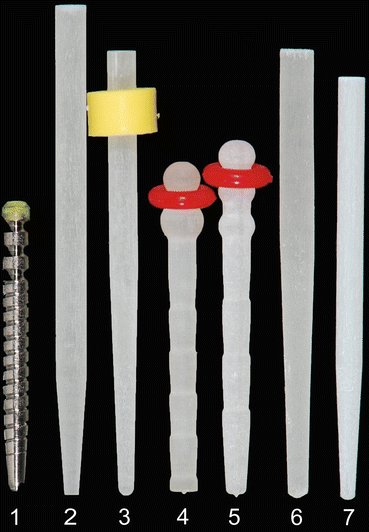

Fig. 6.5
Sample of prefabricated posts currently available 1, Tenax (Coltene); 2, GC Fiber Post (GC Co.); 3, RelyX Fiber Post (3M ESPE); 4, Parapost Fiber Lux (Coltene); 5, Parapost Taper Lux (Coltene); 6, White Post (FGM); 7, Rebilda Post (VOCO GmbH)
Changing a post-hole preparation from tapered to parallel-sided weakens the tooth (Lang et al. 2006). Although previous studies have implied that the retentive strength of posts increased with the use of parallel posts (Cohen et al. 1992; Morgano 1996; Teixeira et al. 2006), a cylindrical post without convergence weakens the apical area of the root that could lead to root fracture (Morgano 1996).
The use of tapered fiber posts over parallel posts is recommended.
6.4 Composition of Fiber Posts
The introduction of the first fiber posts in dentistry, carbon fiber-reinforced resin posts (or carbon fiber posts by Duret et al. 1990), was the milestone that changed some principles behind the restoration of endodontically treated teeth. Originally, carbon fiber posts were made of a matrix based on epoxy resin (64 % by weight) reinforced by unidirectional carbon/graphite fibers with a diameter of 8 μm (Torbjörner et al. 1996). However, carbon fiber posts are dark, therefore lacking cosmetic qualities. Carbon fiber posts were the first acceptable alternative to cast posts and to prefabricated metal or zirconia posts. Post-retained crowns using a carbon fiber post exhibited properties comparable with, and in some cases better than, those of other existing prefabricated posts at least in short-term studies (King and Setchell 1990).
One of the carbon fiber posts currently available in the US market is CF Carbon Fiber Post (J. Morita, USA) (Fig. 6.6a). The diameter of its fibers is 7.25 μm (Fig. 6.6b). White and translucent posts made of glass or silica fibers have been introduced to replace unaesthetic carbon fiber posts with materials with better esthetic qualities (Lassila et al. 2004). Glass fibers have a lower elastic modulus (lower rigidity) than that of carbon fibers (Lassila et al. 2004). Figure 6.7 shows the differences between the surface morphology of a carbon fiber post (Fig. 6.7a) and that of a current glass fiber post (Fig. 6.7b). Current glass fiber posts are translucent, made of a high volume percentage of continuous stretched unidirectional reinforcing glass fibers embedded in a polymer matrix, which keeps the fibers together (Fig. 6.8). The fiber–matrix ratio ranges from 40 to 65 % (Zicari et al. 2013a). The resin matrix usually contains epoxy and/or methacrylate resin with high degree of conversion in a highly cross-linked structure, to which fillers and radiopaque agents may be added as well (Zicari et al. 2013a). Some post systems may also contain PMMA chains of high molecular weight. The matrix is responsible for the fiber composite high mechanical strength and distributes stresses between fibers (Lee and Peppas 1993). Fibers are responsible for resistance against flexure, while the resin matrix provides resistance against compression stress and may interact with functional monomers contained in the adhesive cements (Grandini et al. 2005). As described in Chap. 4, electrical glass (E-glass) is a commonly used glass type. Additionally, glass fiber posts can also be made of quartz fibers. Quartz is pure silica in crystallized form (Lassila et al. 2004).
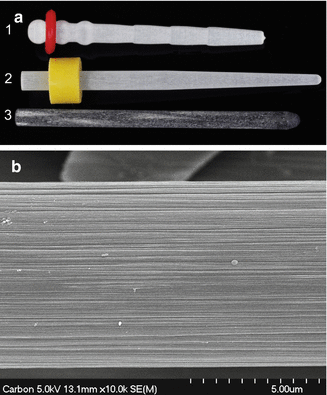
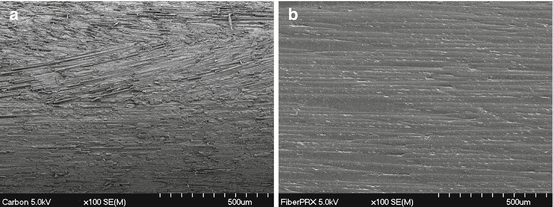
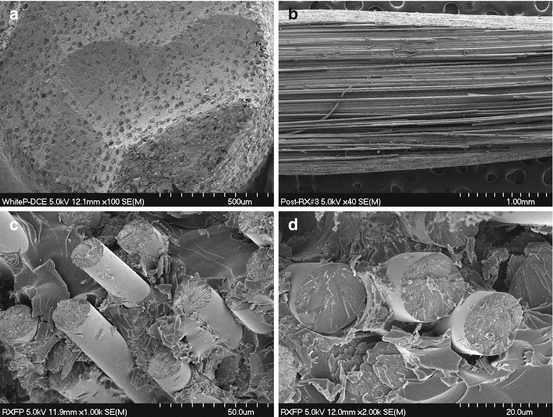

Fig. 6.6
(a) Different fiber posts. (1) Size 5 Parapost Taper Lux (Coltene), (2) Size 2 RelyX Fiber Post (3M ESPE), (3) Size L2, CF Carbon Fiber Post size L2 (J. Morita USA) (b) Scanning electron micrograph depicting an individual carbon fiber (CF Carbon Fiber Post, J. Morita USA). Original magnification = ×10,000

Fig. 6.7
(a) Scanning electron micrograph depicting the side view of a carbon fiber post (CF Carbon Fiber Post, J. Morita USA). Original magnification = ×100. (b) Scanning electron micrograph depicting the side view of a glass fiber post (RelyX Fiber Post, 3M ESPE). Original magnification = ×100

Fig. 6.8
(a) Scanning electron micrograph depicting a cross section of the coronal aspect of a glass fiber post (White Post DC-E, FGM). Original magnification = ×100. (b) Scanning electron micrograph depicting a longitudinal section of a glass fiber post (RelyX Fiber Post, 3M ESPE). Original magnification = ×40. (c) Scanning electron micrograph depicting a glass fiber post sectioned with a diamond bur (RelyX Fiber Post, 3M ESPE). Original magnification = ×1,000. (d) Scanning electron micrograph depicting a glass fiber post sectioned with a diamond bur (RelyX Fiber Post, 3M ESPE). Original magnification = ×2,000
Epoxy resins have long been known for their moisture absorbance (Antoon et al. 1981), which causes degradation (Lee and Peppas 1993). Grant and Bradley (1995) found a 17 % decrease in transverse tensile strength of carbon fiber-reinforced materials, also associated with degradation after moisture absorption. Storage in water significantly decreased both flexural modulus and strength for the carbon fiber posts. Fatigue test resulted in an additional significant reduction of flexural modulus and strength for both the dry and the water-saturated posts. Failures occur mainly in the fiber–matrix interface and as microcracks within the matrix. A reduced adhesion between fibers and matrix as well as matrix cracking was noticed both after water storage and thermocycling (Torbjörner et al. 1996).
For glass fiber posts, thermocycling decreases the flexural modulus by approximately 10 %. Strength and fracture load decreased approximately 18 % as a result of thermocycling (Lassila et al. 2004). A decrease in mechanical properties is taking place during 30 days of water storage and is caused by plasticization of the polymer matrix by water. Due to the different elastic modulus of fibers and resin matrix, stresses normally develop at the interface between fiber and matrix. Vallittu (2000) reported that the quality of the fiber–matrix interface affects the mechanical properties of fiber-reinforced composite (FRC) materials. Without adequate adhesion between these two components, fibers act as voids in the resin matrix, thereby weakening the fiber resin composite.
6.5 Why Fiber Posts?
Some previous studies have focused on the effect of the fiber–matrix ratio (surface occupied by fibers per square millimeter) on the flexural properties of fiber posts. Zicari et al. (2013a) studied the structural characteristics of different fiber posts, including density of fibers, diameter of fibers, fiber–matrix ratio, and distribution of fibers. They found no correlation between these parameters and flexural strength. Grandini et al. (2005) reported no correlation between the fatigue resistance exhibited by fiber posts and their structural characteristics, which included fiber diameter, fiber density, and the surface occupied by fibers per square millimeter of post surface. Seefeld et al. (2007) found a strong and significant linear correlation between the fiber–matrix ratio and the flexural strength of fiber posts. The results of these studies were somewhat contradictory.
When comparing flexural strength of posts with similar dimensions, specific posts perform significantly better than others. For some of them, this might be due to the strengthening effect of zirconia fillers (Zicari et al. 2013a) that are spread among fibers in some fiber posts currently available. When post-cement interfaces are observed under the backscattered field-emission scanning electron microscope (Perdigão, unpublished observations) (Fig. 6.9), filler particles are observed in the matrix of specific fiber posts (Fig. 6.9b) that correspond to those mentioned by Zicari et al. (2013a).
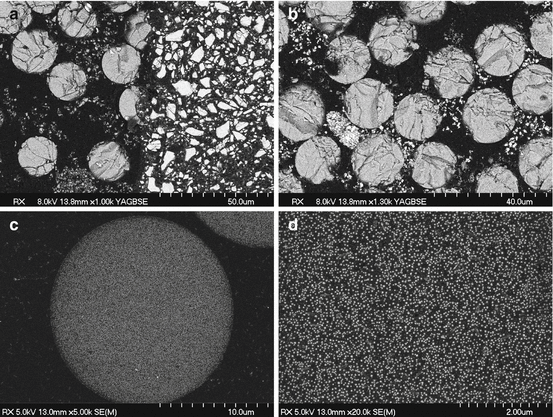

Fig. 6.9
(a) Scanning electron micrograph depicting an interface between a RelyX Fiber Post (3M ESPE) and a self-adhesive resin cement. Original magnification = ×1,000. (b) Scanning electron micrograph depicting a RelyX Fiber Post (3M ESPE). Original magnification = ×1,300. (c) Scanning electron micrograph depicting an individual glass fiber in a RelyX Fiber Post (3M ESPE). Original magnification = ×5,000. (d) Higher magnification of the individual fiber shown in C. Original magnification = ×20,000
6.5.1 Fiber Posts Versus Metal Posts
Many in vitro studies have shown that fiber posts possess some advantages compared to metal posts due to the modulus of elasticity of the former being closer to that of dentin (Lassila et al. 2004; Zicari et al. 2013a, b). However, the modulus of a material is only one parameter influencing stress development.
Fiber posts induce lower stresses than metal posts (Pegoretti et al. 2002; Santos et al. 2010). Additionally, fractures are less likely to occur in the root in endodontically treated teeth restored with fiber posts (Santos et al. 2010). A literature review from 1984 to 2003 comparing modes of failure concluded that significantly more favorable failures occurred with prefabricated fiber post systems than with prefabricated and custom-cast metal post systems (Fokkinga et al. 2004).
The mechanical response of a glass fiber post to loads applied externally was calculated by finite element analysis (FEA) (Pegoretti et al. 2002). The resulting stress was compared with that obtained with a cast metal post and a carbon fiber post and with the response of a natural tooth. The cast post and core produced the greatest stress concentration at the post–dentin interface. On the other hand, the fiber posts presented high stresses in the cervical region due to their flexibility. The glass fiber post resulted in the lowest peak stresses inside the root because its stiffness is similar to that of dentin. Except for the force concentration at the cervical margin, the glass fiber post induced a stress field quite similar to that of the natural tooth (Pegoretti et al. 2002).
Cast metal posts have shown high survival rates after 10 years (Gómez-Polo et al. 2010). Compared to fiber posts, cast metal dowels have the highest resistance to fracture, but may result in non-repairable fractures when used to restore wide root canals. Fractures that occurred with fiber posts and relined posts provided adequate fracture resistance with increased incidence of repairable fractures (Aggarwal et al. 2012). A recent meta-analysis (Zhou and Wang 2013) also concluded that cast posts had higher fracture resistance than fiber posts. However, teeth with cast metal posts had catastrophic failures, such as oblique or horizontal fractures in the middle third of the root or vertical fractures of the root. The failures that occurred with the fiber posts were repairable, such as fractures at the cervical third of roots or the cores (Zhou and Wang 2013).
Cast metal posts and fiber posts can also be used for restoring weakened roots. Bonding cast posts to the tooth structure has a significant effect on compensating for the lack of a ferrule on endodontically treated teeth (Dorriz et al. 2009). When roots were weakened by excess widening of the root canal at the coronal third, fiber posts with a wider cervical emergence diameter were the best clinical solution compared to cast metal posts, even though the prognosis of the restored tooth is questionable. Fractures that occurred with fiber posts were repairable (Wandscher et al. 2014).
6.5.2 Fiber Posts Versus Zirconia Posts
Asmussen et al. (1999) compared some physical properties of carbon fiber posts with those of zirconia and titanium posts. The stiffness of zirconia posts was five times greater than that of carbon fiber posts. The authors described zirconia posts as being brittle without ductility. Carbon fiber posts were described as having elastic limits that were “lower than the strength value, indicating a certain amount of plastic behavior.”
Akkayan and Gülmez (2002) compared the effect of different prefabricated posts (titanium, quartz fiber, glass fiber, and zirconia posts) on the fracture resistance and fracture patterns of crowned endodontically treated teeth. Posts were luted with an etch-and-rinse adhesive and a dual-cure resin cement. All teeth were restored with composite cores; metal crowns were cemented with glass–ionomer cement. Teeth restored with quartz fiber posts resulted in significantly higher failure loads compared to teeth restored with the other three posts. Repairable fractures were observed in teeth restored with fiber posts. Zirconia posts induced more catastrophic root fractures, while teeth restored with fiber posts were less prone to fracture than teeth restored with titanium or zirconia posts (Akkayan and Gülmez 2002).
The survival rates and fracture strength of endodontically treated maxillary incisors with moderate coronal defects restored with different post-and-core systems and fatigued in the artificial mouth were significantly lower for zirconia posts with composite cores, which led the authors not to recommend zirconia posts for clinical use (Butz et al. 2001). The survival rate of zirconia posts was significantly lower than that of fiber posts (Mannocci et al. 1999). In this study, fiber posts reduced to a minimum the risk of root fractures of teeth restored with composite cores and ceramic crowns. While only one fracture occurred in each fiber post group, six failures were observed (one crown fracture and five root fractures + post fractures) in the zirconia post group after intermittent loading in a wet environment (Mannocci et al. 1999).
Fiber posts reduce the risk of root fractures of endodontically treated restored teeth.
6.6 Surface Treatment of Fiber Posts
Several chemo-mechanical surface treatment methods have been used to increase the bonding properties of the surface of fiber posts – hydrofluoric acid, potassium permanganate, sodium ethoxide, sandblasting, and hydrogen peroxide. All these methods have resulted in an interpenetrating network between the treated surface of the fiber post and the composite resin used as luting agent (Monticelli et al. 2006). The penetration of the composite luting material into the spaces between fibers may be a result of increased surface roughness. In fact, it has been shown that hydrofluoric acid, potassium permanganate, sodium ethoxide, and sandblasting all increase post surface roughness (Mazzitelli et al. 2008).
Although results of different studies are contradictory in some cases, immersion in hydrogen peroxide is a promising method to enhance adhesion to fiber posts. Yenisey and Kulunk (2008) studied the effect of hydrogen peroxide and methylene chloride on the shear bond strengths of fiber posts to composite resin. The surface treatment of fiber posts with 10 % hydrogen peroxide for 20 min significantly enhanced the mean shear bond strengths due to the ability of hydrogen peroxide to dissolve the epoxy resin matrix used in each post. Application of methylene chloride to the fiber post surfaces for 5 s was not effective in increasing the shear bond strengths. Similar surface treatments were tested by Elsaka (2013). The application of 30 % hydrogen peroxide or methylene chloride for 5 or 10 min enhanced the adhesion between fiber posts and resin core materials. In another study both 24 and 50 % hydrogen peroxide increased the mean bond strengths of resin to fiber posts, irrespective of the application time (1 min, 5 min, or 10 min). Non-treated posts displayed a relatively smooth surface without fiber exposure. Application of hydrogen peroxide increased the surface roughness and exposed individual fibers (de Sousa Menezes et al. 2011).
Mazzitelli et al. (2012) used two self-adhesive resin cements and five post surface treatments, including silane, 10 % hydrogen peroxide, and sandblasting with silicatization. For one of the posts, the mean pushout bond strengths were similar for all surface treatments. For one of the self-adhesive cements, only silanization improved the pushout bond strengths. Zicari et al. (2012) reported a significantly higher mean pushout bond strength when the post surface was pretreated with sandblasting and silicatization compared to when the post surface was treated with silane or left untreated.
In our laboratory we have been unable to confirm the ability of hydrogen peroxide to transform the surface of fiber posts (Fig. 6.10). Chapters 5 and 9 discuss the post surface treatment in more detail.
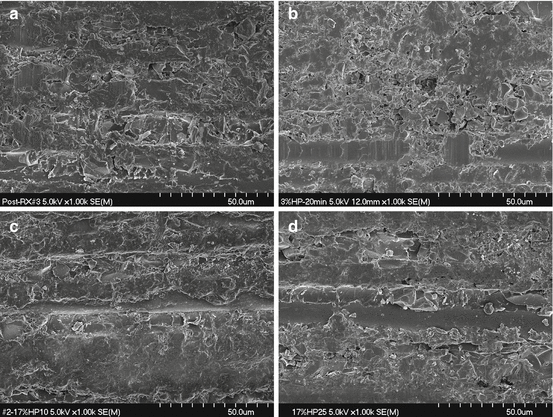

Fig. 6.10
Scanning electron micrographs of the surface of RelyX Fiber Post (3M ESPE). Original magnification = ×1,000. (a) No treatment, (b) treated with 3 % hydrogen peroxide for 20 min, (c) treated with 17 % hydrogen peroxide for 10 min, (d) treated with 17 % hydrogen peroxide for 25 min
6.7 Frequent Myths
6.7.1 Posts Reinforce the Residual Tooth Structure
The primary purpose of a post is to retain a core used to retain the definitive prosthesis. Several authors within the last 40 years have reported that metal dowels do not reinforce endodontically treated teeth when luted with traditional acid–base cements. However, when a prefabricated metal post is luted into the root canal with a resin-based luting cement, the resistance to fracture increased significantly compared to when zinc phosphate was used (Mendoza et al. 1997).
More recently, with the advent of fiber posts and simplified adhesive luting techniques, several authors have described a reinforcement effect from luting fiber posts into the root canal with adhesive materials (Carvalho et al. 2005; Goncalves et al. 2006; Hayashi et al. 2006; D’Arcangelo et al. 2010). Mangold and Kern (2011) evaluated the influence of fiber posts on the fracture resistance of endodontically treated mandibular premolars with varying degrees of substance loss. Post placement had a significant influence on the fracture resistance of endodontically treated premolars; however, the fracture resistance was dependent on the number of residual coronal dentin walls. Placement of a fiber post had a significant influence on the fracture resistance only when fewer than two cavity walls remained.
In summary, there is evidence that adhesively luted fiber posts reinforce the residual tooth structure.
6.7.2 Post Fit Influences Retention
Costa et al. (2012) measured fracture resistance of endodontically treated human premolars restored with bonded fiber posts and a composite buildup. The use of accessory thinner posts to fill in the space between the primary post and the root canal walls did not increase the fracture resistance of teeth. In another in vitro study, post fit did not have a significant influence on fracture resistance, irrespective of the post length, after thermomechanical loading (Büttel et al. 2009). Perdigão et al. (2007) used a small tapered fiber post size with a diameter of 1.50 mm at the coronal end and 0.90 mm at the apical end. The post spaces were prepared with drills of increasingly wider diameter. The diameter of the post space did not significantly affect the pushout bond strengths (Fig. 6.11). Ferrari et al. (2012) reported a lower 6-year failure risk in teeth restored with prefabricated posts than with customized posts.
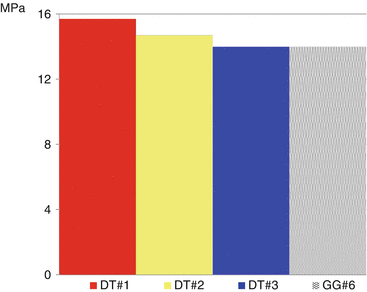

Fig. 6.11
Mean pushout bond strengths (MPa) (adapted from Perdigão et al. 2007) A D.T. Light Post size 1 (Bisco, Inc.) was used for all groups. This post has a diameter of 1.50 mm at the coronal end and 0.90 mm at the apical end. The luting system used was One-Step Adhesive (Bisco, Inc.) and Post Cement Hi-X Self-Cured Resin Cement (Bisco, Inc.). DT#1, #1 D.T. Drill (Bisco Inc.); DT#2, #2 D.T. Drill (Bisco Inc.); DT#3, #3 D.T. Drill (Bisco Inc.); GG#6, #6 Gates-Glidden
The adaptation of the fiber post to the root canal walls does not seem to play a significant role in post retention.
6.7.3 The Coronal Restoration Has the Greatest Impact on the Clinical Success of the Endodontically Treated Tooth
As discussed in Chap. 1, Gillen et al. (2011) performed a systematic review on the impact of the quality of the coronal restoration versus the quality of the root canal filling on the success of the endodontic treatment. These authors found that either the quality of the coronal restoration or the quality of the root canal filling contributes equally to a successful outcome. The odds for healing of apical periodontitis increase with both adequate root canal treatment and adequate restorative treatment.
6.7.4 A Wider Post Space Provides Greater Post Retention Because a Thicker Post Can Be Used
Stress to the root walls generally increases as post diameter increases and as the vertical load increases (Mattison 1982). Over-instrumentation of access preparation and root canals may result in tooth fractures. When endodontically treated teeth were restored with small diameter stainless steel posts, resistance to fracture increased in comparison with the resistance to fracture obtained with larger post sizes (Trabert et al. 1978). Furthermore, varying the dowel diameter has no significant affect on the retentive abilities of metal dowels (Standlee et al. 1978). The use of smaller diameter posts reduces the stresses exerted upon root dentin walls and limits the amount of tooth material removed during preparation. Consequently, the restorative dentist will have more tooth structure to work on, which may aid the operative procedure by limiting the amount of tooth preparation (Mattison 1982). More recently it has been reported that fiber posts with the smallest diameter result in higher flexural strength (Zicari et al. 2013a).
Overpreparation of the post space and larger posts produce no greater reinforcement but actually decrease the resistance to fracture (Trabert et al. 1978; Mattison 1982). Postendodontic tooth fractures might occur because of the loss of tooth structure and stresses caused by restorative procedures such as access cavity preparation, instrumentation and irrigation and obturation of the root canal, post-space preparation, and coronal restoration, and from inappropriate selection of tooth abutments for prostheses (Tang et al. 2010). Potential tooth fractures might be reduced if practitioners are aware of controllable and noncontrollable risks during dental treatments.
In summary, it is not recommended to prepare wider post spaces with the sole goal of inserting a thicker fiber post, as removal of sound tooth structure may be detrimental for the longevity of the endodontically treated tooth.
6.7.5 Translucent Fiber Posts Transmit Light to Cure the Cement in the Root Canal
The available evidence shows otherwise, as translucent posts have limited light transmission (Teixeira et al. 2006; Faria e Silva et al. 2007). Two fiber posts, DT Light Post (Bisco Inc.) and FRC Postec Plus (Ivoclar Vivadent) revealed a light transmission of 10.2 % and 7.7 %, respectively (Kim et al. 2009). Another fiber post, SnowPost (Danville Materials), exhibited a significantly lower value of 0.5 %. The degree of conversion of the luting cement Variolink II (Ivoclar Vivadent) ranged from 32.78 to 69.73 % depending on the depth and type of post (Kim et al. 2009).
There is a significant reduction of the quantity of light transmitted through translucent fiber posts as the depth increases in the root canal. Even without the post, the intensity inside the canal decreases to levels that are insufficient for polymerization, especially in the apical third (dos Santos Alves Morgan et al. 2008).
Translucent posts do not transmit enough light to polymerize resin cements in the apical area of the post space.
6.7.6 Notched Fiber Posts Result in Better Retention than Smooth Fiber Posts
Retention notches (serrations) may decrease fatigue resistance (Grandini et al. 2005). The retention of glass fiber posts is unaffected by surface serrations but is influenced by the resin cement type (Soares et al. 2012). Serrations along the post length may act as points of stress concentration and weaken the post (Zicari et al. 2013a).
Stay updated, free dental videos. Join our Telegram channel

VIDEdental - Online dental courses


